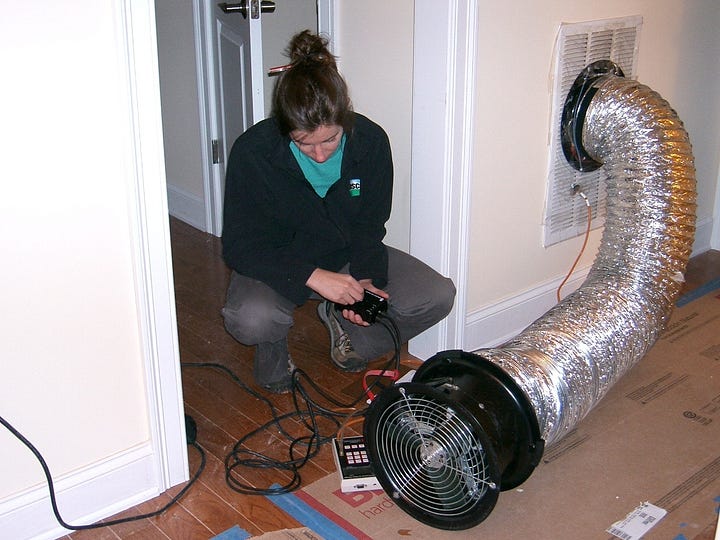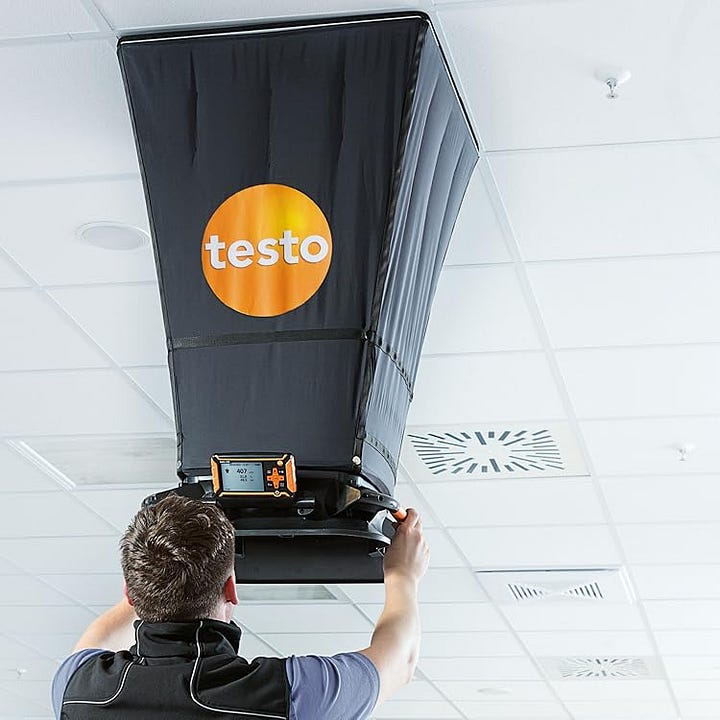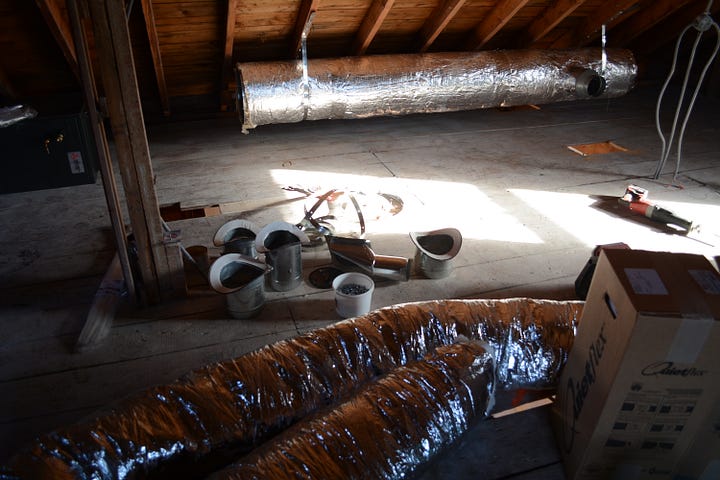Ductwork Quality & Performance Testing
How to tell if the ductwork for your gas/oil furnace (or AC) will work with a heat pump
So maybe you just moved into a house, and you’re thinking of getting a heat pump. There’s existing ductwork already. Can you reuse this existing ductwork for a heat pump?
The really short answer is: maybe. This article covers 2 things you’ll want to check for.
Update: we now have results from ~12 ductwork performance tests this spring. See at bottom.
The Short Answer
You can reuse the ductwork if it’s tightly sealed and the airflow to each room is sufficient under the size & strength of the proposed air handler.
Test #1: Total Duct Leakage


Problem: If your ductwork is leaking conditioned air, then less of it will end up in your living space and your system will be less comfortable. It will also be less efficient.
Test: Test for total duct leakage. Here’s how:
Seal every single ductwork register (opening) except for one return
If the ductwork is super tight, you've just created a sealed space in the ductwork
Attach a fan to the one remaining return, and start pulling air out of the system
If you can pull a deep vacuum, great; that means there aren't a lot of leaks
Use a manometer. You should be able to get to -25 pascal
If you can't get past -3 or -5, or has a tough time getting to -25, that means there are leaks along the ducts
Solution: If you have leaky ductwork but the sizing is ok (see below), you could use Aeroseal to patch up smaller holes. If it’s more substantial than small holes, you may need to replace the ductwork.
You can find more information on this kind of test here, at energy.gov.
Test #2: Undersized Ductwork


Problem: A traditional gas/oil furnace heats air to a higher temperature (130°F+) than a heat pump (~100°F), so you don’t need as much airflow to push the same amount of heat to a conditioned space.
If the ductwork is too small, it reduces the longevity & performance of the heat pump.
Test: Test for undersized ductwork. Here’s how:
Initially, simply ask if there are rooms that feel underheated / underconditioned
Obtain CFM (volumetric airflow) requirements based on the size of the room
Then, put a flow hood over every single supply register to calculate how much airflow is coming out of each register
(Turn the ducted conditioning system on, obviously, so we get airflow.)
If the airflow going into a space isn't up to par with the CFM required when you're using a furnace, it definitely won't be enough when you have a heat pump
To be extra accurate, take into account the size of the furnace; if it's oversized (which is common), it will likely have a stronger fan/blower to squeeze air through the ductwork, which is something that you won’t have with a correctly sized heat pump air handler
Solution: Redo parts of the ductwork that are undersized. See Manual D memo below.
Alternative tests: I suppose static pressure testing would also work here, because the general concept is that if the ductwork is too small, the heat pump blower/fan will have to work extra hard to push enough air through the system to properly condition your space. That extra stress can reduce the lifetime of the blower, and we all hate it when a heat pump system breaks in 6 years instead of 10+.
Green Building Advisors shoutout here.
Bonus #3: Blower Door Test
Problem: If all the warm air is leaking out of your house, it doesn’t matter if your ductwork is tightly insulated.
Solution: Blower door test. This one’s pretty common. While a Mass Save Home Energy Audit can approximate the insulation of your walls, this test will get you the most accurate picture of how much air is leaking out of it.
What about Manual Ds? When do they come in?
While the tests here can check if your existing ductwork system isn’t performing well, it still doesn’t provide a good answer to
If I were to design ductwork from scratch, how large should the ducts be?
That’s where the Manual D comes in. It’s basically the industry standard procedure to calculating & designing new ducted systems.
IF an existing system isn’t sized correctly, or if we’re dealing with a house that doesn’t have ductwork but wants it, the contractor will need to design a system in line with these rules for optimal performance. It’s a lot of work, but it’s worth it.
Is this why contractors oversize heat pumps?
I suspect so. If you have leaky or poorly sized ductwork, contractors in the past can get away with just giving you a bigger furnace. They can do this with heat pumps, too, but it comes at an efficiency & performance cost.
If you want to listen to a truly, truly in-depth 1 hour video on this, see:
Why do you care so much about this?
Laminar Collective at this point has facilitated probably 50+ ducted system installs from our previous bulk deals, and we know far more about ductless system design & quality indicators. It’s about time we gave ducted systems the same treatment.
How much is a test?
Typically, it’s about $250 to $350 per air handler + ductwork system.
We’re putting our money where our mouth is. For our Spring 2025 bulk negotiation, I’m pushing for 40 free ductwork performance tests. If you’ve signed up on the LC website, you’ll be the first to know about it.
Summer Update!
So what ended up happening since we published this article? Well, we did about 12 ductwork tests. Results:
Roughly 50% of the systems passed the test. No remediation needed.
About 40% of the systems had some sort of a leak that needed to be fixed.
Only 1 system out of 12 failed the ductwork test - and it was the 3rd floor of a triple decker, with older metal ductwork.
I’d say the takeaway here is that if your ductwork is newer (<15 years), it’s a coin flip as to whether you need to do remediation. But if it’s:
Really old
Duct run is really long
Ductwork is just really small & seems undersized
then you may have a greater chance of needing a replacement.



When we follow the rules of system design manuals J, S, D we always get predictable results. We know what the system will do and is capable of.
I’d love any links you have about the HZ311 and heat pumps. I have a two floor condo in Somerville with a crazy zone system (one trunk, 17 dampers) and at some point I’d love to switch over. I’ve heard a lot of contradictory views from hvac companies though. Don’t get me started on ERV’s - even worse